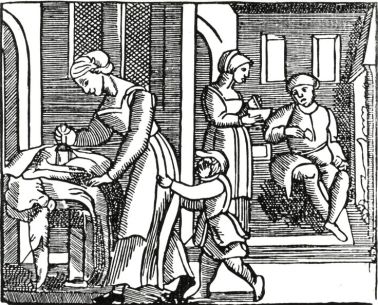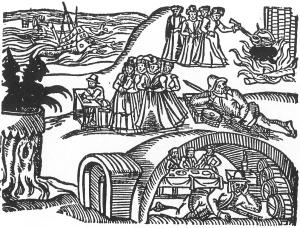
- Upper division history seminar
- 40-student max enrollment
- 1-day per week seminar
- WWW 2018 Syllabus
- Description: Witches, Workers, and Wives uses the period between 1500 and 1800 in Europe and the Atlantic World to offer students an introduction to the history of women, gender, sexuality, and family as well as familiarity with the major historical processes of the early modern period. In this course, we will analyze the complex social, religious, political, and cultural factors that shaped experiences of gender and families on both sides of the Atlantic. These experiences in turn created attitudes, ideas, and stereotypes about gender, sexuality, and power – including how a witch became a quintessential early modern trope. The early modern centuries were years of tremendous change in many ways: religious reform; state-building; colonial expansion; the rise of capitalism; and revolutionary movements. We will examine how women’s experiences of these historical patterns compared to men’s – whether as workers, wives, mothers, consumers, criminals, political subjects and political actors, peasants and nobles, spouses and parents, and even witches. As an upper division seminar, the course’s learning objectives are focused on developing students’ critical thinking and analytical skills. Reading and analyzing a variety of primary and secondary sources, students will become knowledgeable with gender and feminist theory. Students will further develop their discussion skills with the presentation of weekly discussion questions and in-class debate. In addition, students writing is refined through the creation of reading grids on secondary sources, asking students to assess historians’ arguments and bias. The Witchcraft Project Essays/UnEssays assignment requires students to work collaboratively with their peers to analyze a particular witchcraft case from the seventeenth century. Finally, the “From the WWW Archives” piece challenges students to write a public history blog post on a particular translated primary source related to the history of gender, women, family, and/or sexuality. As you can tell, the development of critical reading methods, advanced writing skills, and analytical thinking are cornerstones to this course.
- Julie Hardwick at University of Texas at Austin (my doctoral advisor) came up with this class and engaging title. She has graciously allowed me to use the name and teach my own version of her course.

COURSE OBJECTIVES
Historical and Humanistic Knowledge
- Identify key events and historical players in early modern period in Europe & the Atlantic
- Understand historical change and continuity
- Acknowledge gender as a historical lens
- Develop familiarity with gender and feminist theory
Historical and Humanistic Thinking
- Conceptualize how gender is a socially constructed concept particular to a place and time
- Articulate how sexuality is distinct from gender yet related to it
Historical and Humanistic Skills
- Articulate well-written responses to historical prompts using appropriate evidence
- Assess the credibility, strengths, and weaknesses of primary and secondary sources
- Develop advanced historical questions and debates using primary and secondary sources
- Conduct research collaboratively within groups
- Hone public history skills
Class will be primarily be a discussion. We will read and analyze primary and secondary sources in preparation for class and in class. Considerable time is spent developing students’ writing and analytical skills. Additional instructions on assignments will be distributed to students in class and via Canvas. The following is an overview.
- 20% Participation, Preparation, and Discussion Question(s)
- Discussion Questions: You are expected to attend all class meetings, having read that day’s reading assignment. You will post one discussion question based on the week’s primary and secondary source readings on Canvas by midnight the night before class starts for every class session.
- Participation and Attendance: This class is an upper-division seminar class. A seminar is a class where students are active participants in their learning. In each session, students share their thoughts and analysis with each other and the professor. Aim for at least one contribution to our class discussions per day.
- 20% Reading Grids (5)- You will choose five (5) secondary source readings (meaning articles written by historians) to complete reading grids on. There are many opportunities to complete these grids (almost every week). It is your responsibility to make sure you complete five throughout the semester. You may complete an additional grid to replace your lowest grade. Grids must be submitted via Canvas by 4:00PM the day for which the reading is assigned. No late grids. Grids are not for primary sources.
- 35% Witchcraft Project (Due Mar 27) – You will each receive a witchcraft case from the early modern period. Individually or in small groups (no more than 3 people), you will analyze this document. What does this witchcraft case reveal about the gendered dynamics of the early modern period? Was this case typical or atypical? How, and why? You should choose either OPTION 1 or OPTION 2 for this project:
- Option 1 – Traditional Essay & Presentation: Write a 1500-word (about 5-6 pages, double spaced) essay that analyzes the witchcraft case. You should build a thick historical context. You should address, in general, the gendered dynamics at the time, focusing on why women were often accused as witches. Analyzing the case, what seems “typical” of this case in comparison to others? You should draw on at least two other cases (posted on Canvas under Modules) to make your comparison. Your essay should focus primarily on your own case, but draw examples from these other two cases to support your thesis of whether or not this case was typical/atypical and what this reveals about the gender dynamics of early modern Europe. A list of suggested secondary source readings is provided on Canvas to provide you with additional historical context and analysis. Papers should use Chicago Manual of Style citations (footnotes). You will present your analysis to the class, focusing on your thesis and evidence for 5 minutes.
- Option 2 – The UnEssay & Presentation: Present your analysis of the assigned witchcraft case in any format you would like. Perhaps you make a short podcast, a documentary film, a historical newspaper, a song, a website, or a script to a play based on the case. The possibilities are endless and should speak to your strengths and interests. You will present this “UnEssay” in any format you would like. Regardless of format, it should still focus on answering how this witchcraft case is typical/atypical of other cases and what witchcraft cases reveal about the gender dynamics of early modern Europe. Much like the traditional essay, you should bring in examples from at least two other cases. However, your project should focus primarily on the case you’ve been assigned. You should provide a brief (1-2 pages) explanation of why you chose this medium. Your presentation should address: why you chose this format AND the analysis of your case. Groups or individuals choosing this option will be given 7 minutes to present.
You must make a decision on which option you will complete by Monday, February 5 and notify me. During the week of February 5, you will also come see me to discuss your ideas either for the UnEssay or Traditional Essay. This is to ensure that you understand what is required of you and that your idea is feasible. After this point, you cannot change your option.
- 25% “From the WWW Archives” – Public History Piece – You will pick a translated primary source from the provided list to analyze. In no more than 1200 words, you should write a public history blog piece that analyzes the source’s gendered aspects. You should draw on our secondary sources and your reading grids to help you formulate this analysis. While the majority of the post should concentrate on the analysis of the document, you should consider what this source might be best used for – a research paper on what topic; a lesson on what aspect of gender history? Think carefully about this and reflect. You should look to two public history outlets for inspiration of how to write this assignment: http://notchesblog.com/category/archives-of-desire/ and https://nursingclio.org/articles/
All assignments (except in the case of UnEssays) will be submitted on Canvas.
